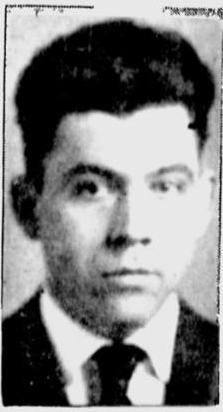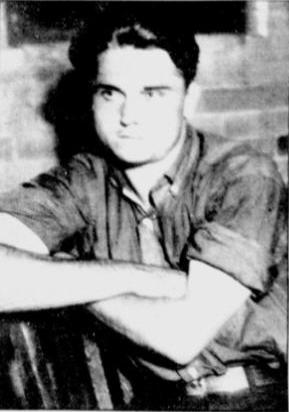Baby Dillinger, Steve Kotowicz
Inspired by John Dillinger, Toledo had seen crimes committed by “baby Dillingers” through the 1930s. Most of these crimes were committed by young men and were hold ups, robberies, car thefts. One of these “baby Dillingers” took things one step too far and he got the death penalty for the murder of a grocer. This man was Steve Kotowicz. Steve was born to Zygmunt and Helen Borkowski on 2 September 1914 and he died in Ohio’s electric chair at the age of 22 on 19 May 1937.
The Kotowicz family initially lived on Kosciusko Street until Zygmunt died in 1923. Helen remarried and the family then settled on Central Ave. by 1930. Kotowicz’s short life was spent in court rooms and jail cells. In 1933, the News Bee published a short mention of Kotowicz as being held to the grand jury under a $1000 bond, arraigned on a charge of burglary. Kotowicz was 18 years old. An indictment for burglary, committed on 16 March 1933, was handed down by the Lucas County Grand Jury on 28 March of that year. On 8 April 1933, he was sentenced to the Mansfield State Reformatory for one to 15 years. He was paroled on 1 November 1934.
On 19 September 1936, Kotowicz held up Mikolajczyk’s grocery story on Lagrange St. with a .45 caliber automatic pistol. The owner, Clement Mikolajczyk was at the store with his wife, Frances, working on their accounts when Kotowicz entered the store. Kotowicz drew the revolver from his pocket and ordered the couple to raise their hands. Mr. Mikolajczyk hesitated. Kotowicz fired a single shot that struck Mikolajczyk in the right arm and then was deflected into his abdomen. Kotowicz fled the scene. However, two neighbors and Frances Mikolajczyk were able to identify Kotowicz and Toledo detective were able to use ballistics information to identify the revolver. A steel jacketed bullet was found on the stretcher that carried Mr. Mikolajczyk to the St. Vincent’s Hospital. That bullet pointed to a revolver that was used in another holdup in which Kotowicz was suspected.

As Mikolajczyk was transported to the hospital, Kotowicz fled and neighbors Louis and Angeline Michalak each were able to provide detailed descriptions of Kotowicz. Mr. Mikolajczyk was questioned in the hospital by city detectives in the hospital. One of the detectives, Bert Dobzeniecki testified that Mikolajczyk said “Hello, Bert, well, they got me right this time!” Per the State’s appeal of Kotowicz’s conviction, this statement was challenged as Mikolajczyk’s competency was questioned as a dying declaration. Mr. Mikolajczyk died the next day in St. Vincent Hospital.
The Michalaks each saw Kotowicz flee from the store, Louis chasing Kotowicz to Streicher Street. Louis stated he then saw a black sedan speed down Franklin Ave. toward downtown. Angeline provided a detailed description of Kotowicz as he almost ran into her on her way into the store.
For nearly three days, Kotowicz eluded police. Initially, Kotowicz went to a cousin’s house on Streicher Street–Mr. and Mrs. Michael Kaminski. Several others provided information on Kotowicz’s whereabouts: Stanley Kaminski (Michael Kaminski’s brother) had said he saw Kotowicz on Lagrange St. the same afternoon and asked him to buy him a drink. Jerome Todak had seen Kotowicz on the Monday after the shooting (21 September) and Kotowicz told him he stuck up a gas station and a pharmacy and the police were after him. Kotowicz asked Todak to lend him money to leave town. Ernest Mazurkiewicz met Kotowicz while he and Todak worked a lunchbox delivery truck over the weekend. Kotowicz asked to borrow money from Mazurkiewicz.
However, the damning information that led to Kotowicz’s arrest was information from the proprietor of the Roanoke Hotel on Superior St, Edward Bash. He informed police that Kotowicz was registered at his hotel under the name of Steve Tiller and that he recognized Kotowicz from a picture in the newspaper. Detectives arrived at the Roanoke Hotel on 22 September and found Kotowicz sleeping in his room. Kotowitcz was arrested and his room was searched. A .45 caliber automatic pistol was found concealed in a drawer of the room.

Mrs. Mikolajczyk was called to a suspect lineup the day of her husband’s funeral on 23 September. She appeared in the Safety Building late that day and identified Kotowicz. Kotowicz was indicted on first degree murder the next day, pled innocent, and was bound over to the grand jury. Kotowicz, when interrogated, maintained his innocence and laughingly provided details of six other robberies he committed. His pistol and the bullet recovered from Mr. Mikolajczyk’s stretcher was sent to Detroit to ballistics experts who confirmed that the bullet that killed Mr. Mikolajczyk was fired from the revolver found in Kotowitcz’s hotel room.
Kotowicz, in November 1936, had his attorney, Eldon Young, file an insanity defense plea ahead of his trial. Trial began on 1 December and ran through 12 December when the jury decided Kotowicz’s fate.
Both the Kaminskis testified at Kotowicz’s trial stating Mr. Kaminski told Kotowicz that if he was caught, he would be burned for it. Mrs. Kaminski testified that Kotowicz listened to radio reports of the shooting and asked her what would happen to the man who shot Mr. Mikolajczyk. She told him he would either go to the electric chair or be in prison for life. Both the Kaminskis testified that Kotowicz said it would be “just too bad if that man kicks off.” Kotowicz’s mother, Helen Makin, testified that she identified a leather jacket as belonging to her son Steve and that the jacket had been in their home the day of the shooting on 19 September. There was earlier testimony that the shooter wore a leather jacket.
The state questioned an alienist (psychologist), Dr. Louis A. Miller, who testified he found no evidence that Kotowicz was insane and that he knew right from wrong on the day of the shooting. Two other doctors testified that they examined Kotowicz and find him to be psychopathic, bolstering Kotowitz’s plea of insanity.
Jurors deliberated 15 hours and could return one of four verdicts: not guilty by reason of insanity; guilty as charged; guilty but with recommendation of mercy with life imprisonment; and not guilty. Jurors returned a verdict of guilty as charged, which meant the death penalty.
Kotowicz was sent to the Ohio Penitentiary in Columbus on 6 January 1937 to await his appeals and death penalty. The appeal was based on Mr. Mikolajczyk’s statement before dying that “they got him right this time”–Kotowicz’s attorney argued whether the statement was admissible and if it was, it did not indicate any robbery had been committed or intended. The appeal did nothing for Kotowicz except to delay his execution from its initial date of 31 March 1937 to 20 May 1937. The governor refused to intervene and Mrs. Mikolajczyk, while saying she did not believe in the death penalty, refused to make a plea for Kotowicz’s life because that would do nothing for her. (Eldon Young, Kotowicz’s attorney, put some pressure on Mrs. Mikolajczyk to come to Columbus and plea for Kotowicz’s life.)
Clement L. Mikolajczyk was 40 years old at the time of his death. He was born in Berea, Ohio and was buried in Calvary Cemetery from St. Adalbert’s Church on 23 September 1936. Besides his wife, Frances, he left behind a son and a daughter, Clement L., Jr. and Elizabeth as well as siblings in Toledo, Cleveland, Berea, Massillon, and Wadsworth, Ohio. His father Leon, living in Berea, also survived him.
Stephen Kotowicz was 22 at the time of his execution. His mother, two sisters, and two brothers survived him. He was buried in Calvary Cemetery from St. Hedwig’s church.